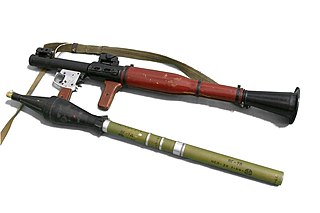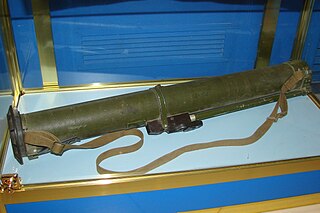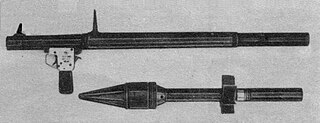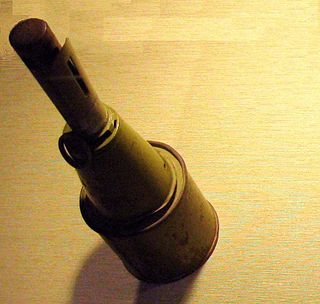
A rocket-propelled grenade (RPG) is a shoulder-fired missile weapon that launches rockets equipped with an explosive warhead. Most RPGs can be carried by an individual soldier, and are frequently used as anti-tank weapons. These warheads are affixed to a rocket motor which propels the RPG towards the target and they are stabilized in flight with fins. Some types of RPG are reloadable with new rocket-propelled grenades, while others are single-use. RPGs are generally loaded from the front.

The Kliment Voroshilov (KV) tanks are a series of Soviet heavy tanks named after the Soviet defence commissar and politician Kliment Voroshilov who operated with the Red Army during World War II. The KV tanks were known for their heavy armour protection during the early stages of the war, especially during the first year of the German invasion of the Soviet Union. In certain situations, even a single KV-1 or KV-2 supported by infantry could halt German formations. The German Wehrmacht at that time rarely deployed its tanks against KVs, as their own armament was too poor to deal with the "Russischer Koloss" – "Russian Colossus".

The Panzer I was a light tank/tankette produced in Nazi Germany in the 1930s. Its name is short for Panzerkampfwagen I, abbreviated as PzKpfw I. The tank's official German ordnance inventory designation was Sd.Kfz. 101.

The Panzerkampfwagen III, commonly known as the Panzer III, was a medium tank developed in the 1930s by Germany, and was used extensively in World War II. The official German ordnance designation was Sd.Kfz. 141. It was intended to fight other armoured fighting vehicles and serve alongside and support the similar Panzer IV, which was originally designed for infantry support.

The Panzerkampfwagen IV, commonly known as the Panzer IV, was a German medium tank developed in the late 1930s and used extensively during the Second World War. Its ordnance inventory designation was Sd.Kfz. 161.

An anti-tank rifle is an anti-materiel rifle designed to penetrate the armor of armored fighting vehicles, most commonly tanks, armored personnel carriers, and infantry fighting vehicles. The term is usually used for weapons that can be carried and used by one person, but is sometimes used for larger weapons. The usefulness of rifles for this purpose ran from the introduction of tanks in World War I until the Korean War. While medium and heavy tank armor became too thick to be penetrated by rigid projectiles from rifles that could be carried by a single soldier, anti-tank rifles continued to be used against other "soft" targets, though recoilless rifles and rocket-propelled grenades such as the bazooka were also introduced for infantry close-layer defense against tanks.

Nashorn, initially known as Hornisse, was a German Panzerjäger of World War II. It was developed as an interim solution in 1942 by equipping a light turretless chassis based on the Panzer III and Panzer IV tanks with the 8.8 cm Pak 43 anti-tank gun. Though only lightly armoured and displaying a high profile, it could penetrate the front armour of any Allied tank at long range, and its relatively low cost and superior mobility to heavier vehicles ensured it remained in production until the war's end.

The RPG-7 is a portable, reusable, unguided, shoulder-launched, anti-tank, rocket-propelled grenade launcher. The RPG-7 and its predecessor, the RPG-2, were designed by the Soviet Union, and are now manufactured by the Russian company Bazalt. The weapon has the GRAU index 6G3.

The RPG-26 Aglen is a disposable rocket-propelled grenade (RPG) anti-tank shoulder-fired missile and launcher developed by the Soviet Union. It fires a one-stage rocket with jack-knife fins, which unfold after launch. The rocket carries a 72.5-millimetre (2.85 in) diameter high-explosive anti-tank (HEAT) single shaped charge warhead able to penetrate 440 millimetres (17 in) of armour, 1 metre of reinforced concrete or 1.5 metres of brickwork. It has a maximum effective range of around 250 metres (820 ft). The similar sized rocket features a slightly heavier and more powerful HEAT warhead and more powerful rocket engine. The limited extension of the RPG-22 launch tube was found of little use. Thus, the RPG-26 has a rigid non-telescoping launch tube.
The RPG-27 is a Soviet single shot disposable rocket-propelled grenade (RPG) shoulder-fired missile and rocket launcher. It entered service with the Soviet Army in 1989.

The RPG-2 is a man-portable, shoulder-fired anti-tank weapon that was designed in the Soviet Union. It was the first successful anti-tank weapon of its type, being a successor to the earlier and unsuccessful rocket-propelled grenade RPG-1.

RKG-3 is a series of Soviet anti-tank hand grenades. It superseded the RPG-43, RPG-40 and RPG-6 series of grenades. It entered service in 1950, and was still being used by insurgents in Iraq and Afghanistan into the 2000s and 2010s, against the vehicles of NATO forces.

The Pak 36 is a 3.7 cm / 37mm caliber German anti-tank gun used during the Second World War. It was the main anti-tank weapon of Wehrmacht Panzerjäger units until 1942. Developed by Rheinmetall in 1933, it was first issued to the German Army in 1936, with 9,120 being available by the beginning of the war in September 1939 and a further 5,339 produced during the war. As the predominant anti-tank gun design in the world during the late 1930s, demand was high for the Pak 36, with another 6,000 examples produced for export and the design being copied by the Soviet Union as the 45 mm anti-tank gun M1932 (19-K) and by other nations such as Japan.

The RPG-16 is a handheld anti-tank grenade launcher for anti-tank warfare. It was developed in 1968 and adopted by the Soviet Army in 1970 for special operation teams and the Soviet airborne troops (VDV). These were deployed during the Soviet–Afghan War in 1979-1989, and saw service in several battles in that theatre.

The Type 69 85mm RPG (69式40毫米火箭筒), made by Norinco, is a Chinese variant of the Soviet RPG-7. First introduced in 1972, the Type 69 is a common individual anti-tank weapon in service with the PLA. More advanced grenade rounds were developed in the 1980s and 1990s to meet the requirements of modern battlefields. Eventually, the aging Type 69 RPG family was replaced by more modern anti-tank weapon systems developed by China such as the Type 89 and Type 08.

The RPG-43 was a high-explosive anti-tank (HEAT) shaped charge hand grenade used by the Soviet Union during World War II. It entered service in 1943, replacing the earlier models RPG-40 and RPG-41; the RPG-40 used a simpler high explosive (HE) warhead. The RPG-43 had a penetration of around 75 millimetres (3.0 in) of rolled homogeneous armour at a 90 degree angle. Later in the war, it was improved and became the RPG-6.

The RPG-6 was a Soviet-era anti-tank hand grenade used during the late World War II and early Cold War period. It was superseded by the RKG-3 anti-tank grenade.

The Panzerwurfmine was a shaped charge hand-thrown anti-tank grenade used by Luftwaffe ground troops in World War II.

Man-portable anti-tank systems are traditionally portable shoulder-launched projectile systems firing heavy shell-type projectiles, typically designed to combat protected targets, such as armoured vehicles, field fortifications and at times even low-flying aircraft.
The 2nd Tank Division was a division of the Red Army and Soviet Ground Forces, which was formed twice under very different circumstances.

















